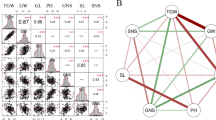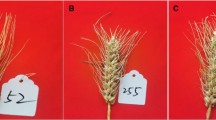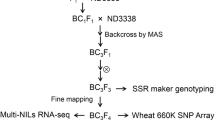Abstract
Key message
This study identified QTLs associated with the functional stay green trait by a high-density genetic map. Two large effect QTLs, QSg.sau-2B.1 and QSg.sau-6A.2, were identified in multiple years and one of them was successfully validated.
Abstract
The functional stay green phenotype enables wheat to acclimate to stressful environments and prolongs the effectiveness of photosynthesis during the end-of-crop season. Despite the fact that stay green mutants in wheat have been reported, our knowledge of loci for the functional stay green trait remains limited. In this study, an RIL population containing 371 lines genotyped using the Wheat55K SNP array was used to map QTLs controlling the functional stay green trait in multiple years. In total, 21 and 19 QTLs were mapped using the BIP or MET modules of the ICIM method, respectively. Among them, two QTLs, QSg.sau-2B.1 and QSg.sau-6A.2, were considered large effect QTLs for the stay green trait and explained 11.43% and 15.27% of phenotypic variation on average, respectively. Two KASP markers were developed and tightly linked to QSg.sau-2B.1 and QSg.sau-6A.2, respectively, and the genetic effects of different genotypes in the RIL population were successfully confirmed. QSg.sau-2B.1 was also validated by linked KASP marker in different genetic backgrounds. QSg.sau-2B.1 and QSg.sau-6A.2 may influence heredity of the stay green trait and also exhibited a positive effect on the grain filling content. In the interval where QSg.sau-2B.1 and QSg.sau-6A.2 were located on the Chinese Spring and T. turgidum ssp. dicoccoides reference genomes, several genes associated with the leaf senescence process were identified. Altogether, our results identified two QTLs associated with the functional stay green trait and will be useful for the fine mapping and cloning of genes for stay green in the future.







Similar content being viewed by others
Availability of data and material
All experiments and data analyses were conducted in Sichuan, and the Wheat55K SNP genotyping was done at CapitalBio Technology Company in Beijing, China.
Code availability
Not applicable.
References
Buchanan-Wollaston V, Ainsworth C (1997) Leaf senescence in Brassica napus: cloning of senescence-related genes by subtractive hybridization. Plant Mol Biol 33:821–834
Cao G, Zhu J, He C, Gao Y, Yan J, Wu P (2001) Impact of epistasis and QTL×environment interaction on the developmental behavior of plant height in rice (Oryza sativa L.) Theor Appl Genet 103(1):118–123
Chaves M, Martinelli J, Wesp C, Graichen F, Brammer S, Scagliusi S, Silva P, Wiethölter P, Torres G, Lau E, Consoli L, Chaves A (2013) The importance for food security of maintaining rust resistance in wheat. Food Secur 5(2):157–176
Checovich ML, Galatro A, Moriconi JI, Simontacchi M, Dubcovsky J, Santa-Maria GE (2016) The stay-green phenotype of TaNAM-RNAi wheat plants is associated with maintenance of chloroplast structure and high enzymatic antioxidant activity. Plant Physiol Biochem 104:257–265
Chen JB, Liang Y, Hu XY, Wang XX, Zhang HQ, Ren ZL, Luo PG (2010) Physiological characterization of “stay green” wheat cultivars during grain filling stage under field growing conditions. Acta Physiol Plant 32:875–882
Chen Y, Xu Y, Luo W et al (2013) The F-box protein OsFBK12 targets OsSAMS1 for degradation and affects pleiotropic phenotypes, including leaf senescence, in rice. Plant Physiol 163(4):673–1685
Christopher M, Chenu K, Jennings R, Fletcher S, Butler D, Borrell A, Christopher J (2018) QTL for stay-green traits in wheat in well-watered and water limited environments. Field Crop Res 217:32–44
Christopher JT, Borrell A, Manschadi AM, Hammer GL, Chapman S (2004) Developing high yielding wheat for water limited environments in northern Australia. In: Proceedings of the 4th international crop science congress, Brisbane, Australia. http://espace.library.uq.edu.au/view/UQ:101247
Christopher M, Paccapelo V, Kelly A, Macdonald B, Hickey L, Richard C, Verbyla A, Chenu K, Borrell A, Amin A, Christopher J (2021) QTL identified for stay-green in a multi-reference nested association mapping population of wheat exhibit context dependent expression and parent-specific alleles. Field Crops Res 270:108181
Fang C, Li C, Li W, Wang Z, Zhou Z, Shen Y, Wu M, Wu Y, Li G, Kong L et al (2014) Concerted evolution of D1 and D2 to regulate chlorophyll degradation in soybean. Plant J 77(5):700–712
Gao Q, Yang Z, Zhou Y et al (2012) Characterization of an Abc1 kinase family gene OsABC1-2, conferring enhanced tolerance to dark-induced stress in rice. Gene 498(2):155–163
Hammer GL, Kropff MJ, Sinclair TR, Porter JR (2002) Future contributions of crop modelling-from heuristics and supporting decision making to understanding genetic regulation and aiding crop improvement. Eur J Agron 18:15–31
Haussmann B, Mahalakshmi V, Reddy B et al (2002) QTL mapping of stay-green in two sorghum recombinant inbred populations. Theor Appl Genet 106(1):133–142
Hu ZL, Deng L, Yan B, Pan Y, Luo M, Chen XQ, Hu TZ, Chen GP (2011) Silencing of the LeSGR1 gene in tomato inhibits chlorophyll degradation and exhibits a stay-green phenotype. Biol Plantarum 55(1):27–34
Jiang GH, He YQ, Xu CG, Li XH, Zhang Q (2004) The genetic basis of stay-green in rice analyzed in a population of doubled haploid lines derived from an indica by japonica cross. Theor Appl Genet 108(4):688–698
Joshi AK, Kumari M, Singh VP, Reddy CM, Kumar S, Rane J, Chand R (2007) Stay green trait: variation, inheritance and its association with spot blotch resistance in spring wheat (Triticum aestivum L.). Euphytica 153:59–71
Kiranmayee U, Hash CT, Sivasubramani S et al (2020) Fine-Mapping of sorghum stay-green QTL on Chromosome10 revealed genes associated with delayed Senescence. Genes Dev 11(9):1–26
Kumar U, Joshi AK, Kumari M et al (2010) Identification of QTLs for stay green trait in wheat (Triticum aestivum L.) in the ‘Chirya 3’ × ‘Sonalika’ population. Euphytica 174:437–445
Kumari M, Pudake RN, Singh VP, Joshi AK (2013) Association of staygreen trait with canopy temperature depression and yield traits under terminal heat stress in wheat (Triticum aestivum L.). Euphytica 190:87–97
Liu K, Yan G, Zhang G, Sun M (2019) Advances in molecular genetics of rice stay green mutation. Jiangsu J Agric Sci 35(2):484–488
Luo P, Ren Z, Wu X, Zhang H, Zhang H, Feng J (2006) Structural and biochemical mechanism responsible for the stay-green phenotype in common wheat. Chin Sci Bull 51(21):2595–2603
Ma J, Zhang H, Li S, Zou Y, Li T, Liu J, Ding P, Mu Y, Tang H, Deng M, Liu Y, Jiang Q, Chen G, Kang H, Li W, Pu Z, Wei Y, Zheng Y, Lan X (2019) Identification of quantitative trait loci for kernel traits in a wheat cultivar Chuannong16. BMC Genet 20:77
Meng L, Li HH, Zhang LY, Wang JK (2015) QTL IciMapping: Integrated software for genetic linkage map construction and quantitative trait locus mapping in biparental populations. Crop J 3:269–283
Mostafa A, El-S M, Sudisha J, David JB, Lam-Son PT (2017) The “STAY-GREEN” trait and phytohormone signaling networks in plants under heat stress. Plant Cell Rep 36:1009–1025
Nagahage ISP, Sakamoto S, Nagano M, Ishikawa T, Mitsuda N, Kawai-Yamada M, Yamaguch M (2020) An Arabidopsis NAC domain transcription factor, ATAF2, promotes age-dependent and dark-induced leaf senescence. Physiol Plant 172(2):299–308
Nakano M, Yamada T, Masuda Y et al (2014) A green-cotyledon/stay-green mutant exemplifies the ancient whole-genome duplications in soybean. Plant Cell Physiol 55(10):1763–1771
Nawaz A, Farooq M, Cheema SA et al (2013) Stay green character at grain filling ensures resistance against terminal drought in Wheat. Int J Agric Biol 5(6):1379–1388
Park SY, Yu JW, Park JS, Li JJ et al (2007) The senescence-induced stay green protein regulates chlorophyll degradation. Plant Cell 19(5):1649–1664
Raghavendra AS, Sane PV, Mohanty P (2006) Photosynthesis research in India: transition from yield physiology into molecular biology. Photosynth Res 76(1–3):435–450
Rampino P, Spano G, Pataleo S, Mita G, Napier JA, Di Fonzo N, Shewry PR, Perrotta C (2006) Molecular analysis of a durum wheat “stay green” mutant: Expression pattern of photosynthesis-related genes. J Cereal Sci 43(2):160–168
Ray DK, Mueller ND, West PC, Foley JA (2013) Yield trends are insufficient to double global crop production by 2050. PLoS ONE 8(6):e66428
Ren GD, An K, Liao Y, Zhou X, Cao YJ, Zhao HF, Ge XC, Kuai BK (2007) Identification of a novel chloroplast protein AtNYE1 regulating chlorophyll degradation during leaf senescence in Arabidopsis. Plant Physiol 144(3):1429–1441
Ren T, Hu Y, Tang Y, Li C, Yan B, Ren Z, Tan F, Tang Z, Fu S, Li Z (2018) Utilization of a Wheat55K SNP array for mapping of major QTL for temporal expression of the tiller number. Front Plant Sci 9:333. https://doi.org/10.3389/fpls.2018.00333
Ren T, He M, Sun Z, Tan F, Luo P, Tang Z, Fu S, Yan B, Ren Z, Li Z (2019) The polymorphisms of oligonucleotide probes in wheat cultivars determined by ND-FISH. Molecules 24:1126
Ren TH, Fan T, Chen SL, Li CS, Chen YY, Ou X, Jiang Q, Ren ZL, Tan FQ, Luo PG, Chen C, Li Z (2021a) Utilization of a Wheat55K SNP array-derived high-density genetic map for high-resolution mapping of quantitative trait loci for important kernel-related traits in common wheat. Theor Appl Genet 134:807–821
Ren T, Fan T, Chen S, Ou X, Chen Y, Jiang Q, Diao Y, Sun Z, Peng W, Ren Z, Tan F, Li Z (2021b) QTL Mapping and validation for kernel area and circumference in common wheat via high-density SNP-based genotyping. Front Plant Sci 12:713890. https://doi.org/10.3389/fpls.2021.713890
Reynolds MP, Rajaram S, Sayre KD (1999) Physiological and genetic changes of irrigated wheat in the post-green revolution period and approaches for meeting projected global demand. Crop Sci 39:1611–1621
Semagn K, Babu R, Hearne S, Olsen M (2014) Single nucleotide polymorphism genotyping using Kompetitive Allele Specific PCR (KASP): overview of the technology and its application in crop improvement. Mol Breed 33:1–14
Shi S, Azam FI, Li H et al (2017) Mapping QTL for stay-green and agronomic traits in wheat under diverse water regimes. Euphytica 213(11):246
Silva SA, Carvallo FIF, Caetano VR, Oliveira AC, Coimbra JLM, Vasconcellos NJS, Lorencetti C (2000) Genetic basis of stay green trait. J New Seeds 2:55–68
Simone V, Soccio M, Borrelli GM, Pastore D, Trono D (2013) Stay-green trait-antioxidant status interrelationship in durum wheat (Triticum durum) flag leaf during post-flowering. J Plant Res 127:159–171
Spano G, Di FN, Perrotta C et al (2003) Physiological characterization of “stay green” mutants in durum wheat. J Exp Bot 54(386):1415–1420
Sun P, Wu Q, Xu B, Chang S, Miao H, Jing Z (2015) Progress in research on STAY-GREEN genes in plants. Plant Physiol J 51(7):1017–1023
Sun C, Dong Z, Zhao L, Ren Y, Zhang N, Chen F (2020) The Wheat 660K SNP array demonstrates great potential for marker-assisted selection in polyploid wheat. Plant Biotechnol J 18:1354–1360
Thomas H, Howarth CJ (2000) Five ways to stay green. J Exp Bot 51:329–337
Tian F, Gong J, Zhang J et al (2013) Enhanced stability of thylakoid membrane proteins and antioxidant competence contribute to drought stress resistance in the tasg1 wheat stay-green mutant. J Exp Bot 64(6):1509–1520
Uauy C, Distelfeld A, Fahima T, Blechl A, Dubcovsky J (2006) A NAC gene regulating senescence improves grain protein, zinc and iron content in wheat. Science 314(5803):1298–1301
Van den Burg HA, Tsitsigiannis DI, Rowland O, Lo J, Rallapalli G, MacLean D, Takken F, Jones JD (2008) The F-box protein ACRE189/ACIF1 regulates cell death and defense responses activated during pathogen recognition in tobacco and tomato. Plant Cell 20:697–719
Verma V, Foulkes MJ, Worland AJ, Sylvester-Bradley R, Caligari PDS, Snape JW (2004) Mapping quantitative trait loci for flag leaf senescence as a yield determinant in winter wheat under optimal and drought-stressed environments. Euphytica 135(3):255–263
Wang AY, Li Y, Zhang CQ (2012) QTL mapping for stay-green in maize (Zea mays). Can J Plant Sci 92(2):249–256
Wang W, Hao Q, Tian F et al (2016) The stay-green phenotype of wheat mutant tasg1 is associated with altered cytokinin metabolism. Plant Cell Rep 35(3):585–599
Wang W, Hao Q, Wang W, Li Q, Chen F, Ni F, Wang Y, Fu D, Wu J, Wang W (2019) The involvement of cytokinin and nitrogen metabolism in delayed flag leaf senescence in a wheat stay-green mutant, tasg1. Plant Sci 278:70–79
Wang N, Liu Z, Zhang Y et al (2018) Identification and fine mapping of a staygreen gene (Brnye1) in pakchoi (Brassica campestris L.ssp.chinensis). Theor Appl Genet 131(3):1–12
Yan J, He C, Jing W et al (2004) Overexpression of the Arabidopsis 14-3-3 protein GF14λ in cotton leads to a “Stay-Green” phenotype and improves stress tolerance under moderate drought conditions. Plant Cell Physiol 45(8):1007–1014
Yang XT, Zhang ZQ, Joyce D, Huang XM, Xu LY, Pang XQ (2009) Characterization of chlorophyll degradation in banana and plantain during ripening at high temperature. Food Chem 114(2):383–390
Yang XT, Song J, Fillmore S, Pang XQ, Zhang ZQ (2011) Effect of high temperature on color, chlorophyll fluorescence and volatile biosynthesis in green-ripe banana fruit. Postharvest Biol Tec 62(3):246–257
Zheng HJ, Wu AZ, Zheng CC, Wang YF, Cai R, Shen XF, Xu RR, Liu P, Kong LJ, Dong ST (2009) QTL mapping of maize (Zea mays) stay-green traits and their relationship to yield. Plant Breed 128(1):54–62
Acknowledgements
We gratefully acknowledge the financial support from the National Natural Science Foundation of China (#31801357) and Foundation of Sichuan Province Science and Technology Support Program (#2019YJ0510, #2021YJ0509, #2021JDRC0127).
Funding
National Natural Science Foundation of China (#31801357) and Foundation of Sichuan Province Science and Technology Support Program (#2019YJ0510, #2021YJ0509, #2021JDRC0127).
Author information
Authors and Affiliations
Contributions
TR and ZL designed the experiments; TR and ZR created the RIL population; TR, TF, SC, YC, XO, QJ and WP participated in phenotype measurement; TR, ZL PL and TF participated in data analysis and processing; TF performed QTL analysis; FT performed the field management; TR wrote the manuscript. All authors participated in the research and approved the final manuscript.
Corresponding authors
Ethics declarations
Conflict of interest
All authors declare that they have no conflict of interest.
Ethical standards
We declare that these experiments complied with the ethical standards in China.
Consent for publication
All authors contributed to the study and approved the final version for submission.
Additional information
Communicated by Gary Muehlbauer.
Publisher's Note
Springer Nature remains neutral with regard to jurisdictional claims in published maps and institutional affiliations.
Supplementary Information
Rights and permissions
About this article
Cite this article
Ren, T., Fan, T., Chen, S. et al. Identification and validation of quantitative trait loci for the functional stay green trait in common wheat (Triticum aestivum L.) via high-density SNP-based genotyping. Theor Appl Genet 135, 1429–1441 (2022). https://doi.org/10.1007/s00122-022-04044-9
Received:
Accepted:
Published:
Issue Date:
DOI: https://doi.org/10.1007/s00122-022-04044-9




